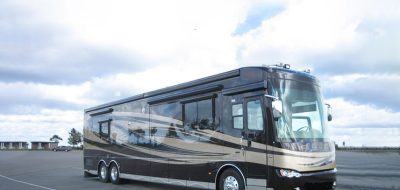A few weeks ago I was contacted by Jose Adauto de Souza, who lives and works in Brazil. Adauto is a Petroleum Geologist/Geophysicist close to being retired. Since 1978 he has been a camping enthusiast, starting with tents, then a pop-up, travel trailers and now has a Class A motorhome. (I have been through the same RV progression, and around the same time frame as Adauto).
He is a member of a regional RVing group in Rio de Janeiro State called “Amigos do Rio RV Group (Rio’s Friends) (Brazil)”. Over the last year Adauto has been researching and compiling free RV information for other RV enthusiasts in Brazil, since they do not have a bibliography about RVing in Brazil. He was working on a trailer sway article when he contacted me, to help educate some of the RVers in his group on sway issues. He wanted to know if I would be interested in working together with him on the article. At times it was a bit difficult to tranlate what each of us were saying to each other, but I think we figured it out.
This is part 1 of 2. I will publish part 2 of the article next week.
 –
–
Trailer sway, that sideto-side fishtailing movement, (Figure 1) occurs when there is a force perpendicular to the tow vehicle and trailer trajectory, applied to the hitch ball. An important factor in controlling sway is the amount of tongue weight applied to the hitch ball, and how that weight is distributed to the tires on the tow vehicle. A general rule is trailer tongue weight should be 10 to 15% of the fully loaded trailer weight, for trailers weighing over 2,000 pounds. If the tongue weight (what generates friction to the tow vehicle rear tires) is properly distributed to the rear tires of the tow vehicle most lateral forces encountered will not be sufficient to start sway. If the lateral forces do overcome the tire friction trailer sway will start.
This would be a good time to include an analysis about tow vehicle and trailer traffic speed. As speed increases, tire traction decreases with a corresponding increase in the possibility of trailer sway. At 60 mph, and under wet road conditions, a weak lateral wind may start a lateral trailer displacement.

Natural trailer balance, when travelling, may be understood as a vertical pendulum, but in the opposite direction (Figure 2). The trailer sway is similar, but the displacement is horizontal, over the road, with the trailer (and the tow vehicle by consequence) going from one side to the other many times. If the trailers vertical stabilization, associated with the suspension, is working properly it helps in preventing small sways. Weight distribution bars reduce vertical displacements (swings) and transfers the hitch weight to the vehicle and trailer tires. This results in the rear tires gripping the road better, and may avoid these sideslips. So, it is important, before leaving on a trip, that we complete a checklist of all items associated with the tow vehicle and trailer stabilization. These checks would include inspecting items like tires, weight distributing bars, proper hitch adjustments, the trailer and tow vehicle suspension systems, and that all cargo is distributed evenly. If these items are not in a good shape, it will decrease the speed that we can safely travel at.
The bigger the trailer is (taller and longer) increases the chance for sway. There are two reasons for this, an increase in weight and an increase in mass (the area that will receive lateral winds). Weight increase will augment the forces applied to the hitch ball, especially when traveling downhill, due to the gravity, acceleration and also in case of any vehicle brake activation. If there is any unbalanced item in the towing system, it may become sufficient to start sway. If the trailers lateral area is larger, the amount of forces due to lateral winds is also increased. These forces may destabilize the tow vehicle and trailer motion, increasing the chance for sway.

There is another very important item associated with sways, and that is the number of trailer axles. Compared to one axle, two trailer axles increases the number of wheels 100% over the ground, and by consequence the increased tires gripping the road decreases the chance for sway. Another peculiarity associated with one axle is the vertical motion (front-back direction, referred to as porpoising) associated with vehicle brake activation (Figure 3). In this situation the trailers front end will tend to push downward. This vertical downward motion enhances the tow vehicles back wheel traction, but decreases the front wheel traction, and the forces applied in the opposite direction (up) will reduce the tow vehicles rear wheels traction. Depending upon total weight balance, the tow vehicle and trailer may start a back or front sway and the tow vehicles front motion control will be compromised. It is well known that for both single and dual axle trailers, the larger the trailer is the more unstable it is when talking about porpoising. Proper hitch work can mitigate some of this from occuring.
Statistics prove that 5th wheel trailers are more stable and sways associated with them are seldom reported. Why? It is mainly because a more stable condition is obtained due to the 5th wheel hitch being positioned over and close to the towing vehicle rear axle. In the case of a 5th wheel, lateral forces do not affect it like a trailer that is hitched at the rear of the tow vehicle. The weight at the hitch position of a 5th wheel trailer is higher and over the axle, enhancing the tow vehicle traction on the road surface. But, when towing a 5a wheel, the driver must be more careful in descending an incline because the natural tendency will be for the weight of the trailer to push the towing vehicle.
Always keep in mind the towing vehicle has a maximum tow capacity and that you must compute total RV weights including, passengers, cargo, and fluids and fuel. Also keep in mind that any weight added to the tow vehicle takes the same amount of weight from the towing capacity.
The most important items associated with trailer sways are:
a) underinflated tires
b) improper weight distribution
c) improper hitch adjustments
d) no sway control
e) air pressure from transfer trucks passing
f) long downhill (descent)
g) lateral wind
h) towing speed
i) inadequate towing vehicle
j) overload conditions
k) hitch to tow vehicle rear axle distance
l) poor trailer design
m) Mismatched tow vehicle & trailer
n) Not completing trailer/tow vehicle checklist
This article was written by Jose Adauto de Souza & Mark Polk
Tune in next week for part 2 of the article when we discuss what you can do to help control trailer sway.
Happy Camping,
Mark Polk








Pingback: The Unemployed Mom
Gianna Freerksen
After I initially commented I clicked the -Notify me when new feedback are added- checkbox and now every time a remark is added I get 4 emails with the identical comment. Is there any method you’ll be able to remove me from that service? Thanks!
Gema Mespelt
I’ll immediately grab your rss as I can not find your email subscription link or e-newsletter service. Do you’ve any? Please let me know in order that I could subscribe. Thanks.
mikrolån 500
Certainly I like your web site, but you need to take a look at the spelling on several of your posts. Several of them are rife with spelling problems and I find it very silly to inform you. Nevertheless I will surely come again again!
Ana Kimmey
I have been surfing online more than three hours today, yet I never found any interesting article like yours. It’s pretty worth enough for me. Personally, if all site owners and bloggers made good content as you did, the internet will be much more useful than ever before.
colon cleansing
This is a good style for me. thanks for the hard work.
Jeni Suddeth
Normally I do not read article on blogs, but I would like to say that this write-up very forced me to try and do it! Your writing style has been surprised me. Thanks, very nice article.
colon cleanse
Great job. keep it up.
Optymalizacja
Hi there, You’ve done an excellent job. I’ll certainly digg it and personally recommend to my friends. I am confident they will be benefited from this website.
smslån utan kreditprövning
Good write-up. I am a regular visitor of your site and appreciate you taking the time to maintain the nice site. I will be a regular visitor for a really long time.
Cassidy Musquiz
I together with my pals appeared to be digesting the best helpful hints on the blog and then the sudden developed a terrible feeling I had not expressed respect to the website owner for them. Most of the men are already totally glad to see them and have certainly been enjoying those things. Appreciate your being considerably accommodating and for getting certain brilliant subjects most people are really eager to learn about. Our sincere regret for not saying thanks to sooner.
Caravan Insurance guy
You can reduce the chance of swaying and pitching if you pack your trailer correctly. You need to keep heavy items low and over the axles. The weight distribution needs to be such that you have the correct nose weight on the hitch.
Barb Kraus
We have had a Hensley Hitch on our 30 foot travel trailer since we bought it in 2004. I’ve never heard you mention this hitch in either your videos or online. We don’t experience trailer sway with this hitch when we travel–not in high winds nor due to truck traffic. We do keep our tires inflated equally and our trailer rides level due to the drawbar provided with the hitch (exchangeable at no charge should we change vehicles and need a different “drop” to keep the trailer level). This hitch is expensive, but it really does a great job. Do you have any comments about this hitch and how it performs? By the way, the folks at Hensley are great regarding questions about the hitch.
S.C. Okie
How akin to ‘fish-tailing’ is sway?
Also, on a recent trip from South Carolina to Key West, Fla., we experienced a sway problem. Used 3rd link on chain on bar and sway control was installed—snug. On return trip, we used the 4th link on chain and tightened sway good and tight, but NOT overtightened. The last two did help with part of the sway, but not all by a longshot. Going over the “Seven Mile Bridge” didn’t get exciting and sure felt a lot of wind up that high! A constant breeze thoughtout the keys after leaving Key Largo, especially where there isn’t much vegetation along the edges of the road. The water is about 30-50 feet away, (more or less in some spots), from the edge of the road on both sides of U.S. #1!
My question is: How did changing the chain links on the bars make any difference in the sway? I know that tightening the sway control helped.
If anyone has some good ideas as to an answer, please e-mail me. Just add: @sc.rr.com to my name. (All of it in lower case).
Thanks! 🙂
Harold DeVries
Add to this list:
O) All tires need to be inflated having the same pressure.
P) The less distance there is between the hitchball and the rear axle the less sway will be experienced .
Q) get a Hensley hitch,it solves all problems .